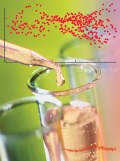 The latest issue of SpectroscopyNOW is online. This week I cover everything from MRI for testicular cancer to egg-shaped carbon balls by way of energy molecules, copper proteins, secret writing, first up a forensic science test for distinguishing saliva deposits from other substances at a crime scene:
The latest issue of SpectroscopyNOW is online. This week I cover everything from MRI for testicular cancer to egg-shaped carbon balls by way of energy molecules, copper proteins, secret writing, first up a forensic science test for distinguishing saliva deposits from other substances at a crime scene:
Non-destructive spit test – Raman spectroscopy can identify samples of an unknown substance at a crime scene as human saliva during forensic analysis, according to a US study, the technique would preserve DNA evidence. I asked research team leader, Igor Lednev to tell me about his aspirations for the technique.
“The major motivation of this research project, funded by the National Institute of Justice, is to bring our novel method to the forensic lab and a crime scene as soon as possible,” he told me. “The method is at the developmental stage at the moment and several further developments need to be done before moving to the “real” world crime scene.” These include (i) automation of the technique and making it a user-friendly “black-box type” apparatus, (ii) expansion to potential mixtures of body fluids, (iii) protection from possible interference from substrate materials and possible contaminants, and (iv) expansion to possible evidence degradation under various environmental conditions.
To achieve those goals the team is collaborating with “real world” practitioners, CSIs including Barry Duceman, Director of Biological Science, at the NY State Police Forensic Investigation Center and John Hicks, Director of the Northeast Research Forensic Institute. Lednev revealed to me that a first prototype of the device should be in forensic laboratories within two to three years.
Also, in my SpectroscopyNOW column this week:
MRI on the ball – MRI proves to be a good diagnostic tool for testicular cancer and could spare some men unnecessary surgery.
Focus on energy molecule – Organisms use ATP as a universal energy storage molecule, now carbon nanotubes, modified with luciferase, have been used as near-infrared detectors for cellular ATP. The work has potential for studies of ischaemia, Parkinson’s disease, hypoglycaemia and more.
Copper, on the beat with NMR – The first NMR spectroscopy study of the copper site in an important blue metalloprotein, azurin, has been undertaken. Copper mediates many biochemical redox reactions and azurin plays an important role in catalysing electron transfer in cellular reactions.
Sunscreen spies – Sunscreen and boron can work together to make a compound that changes colour when touched under ultraviolet light. The compound changes from blue-green to yellow with the gentlest of rubs and then reverts quickly to blue-green when gently warmed, although the process is reversible at room temperature.
Bucky eggs cracked – Unusual egg-shaped fullerene molecules are rulebreakers because they do what no other fullerenes seem to do – fuse three pentagons of carbon atoms, according to chemists in China. The discovery of these molecules could lead to new insights into fullerene chemistry as well as offering new opportunities for synthesising novel materials.
Forensic saliva test montage by Albany’s Aliaksandra Sikirzhytskaya.
![]() Virkler, K., & Lednev, I. (2010). Forensic body fluid identification: The Raman spectroscopic signature of saliva The Analyst, 135 (3) DOI: 10.1039/b919393f
Virkler, K., & Lednev, I. (2010). Forensic body fluid identification: The Raman spectroscopic signature of saliva The Analyst, 135 (3) DOI: 10.1039/b919393f